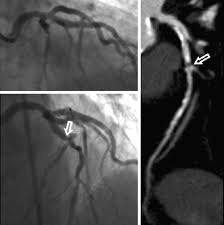CARDIAC CTA
 |
With recent advances in technology, it is now possible to image the heart with such great detail and speed that a cardiac diagnosis can be made in seconds without an invasive procedure. |
What is a Cardiac CTA used for?
A Coronary CTA is a heart-imaging test to determine whether either fatty deposits or calcium deposits have built up in the coronary arteries, which supply blood to the heart muscle. If left untreated, these areas of build-up, called plaques, can cause heart muscle disease. Heart muscle disease, in turn, can lead to fatigue, shortness of breath, chest pain and/or heart attack.
How does a Cardiac CTA differ from the Heart Scores
Patients undergoing a Coronary CTA scan receive an injection of dye containing iodine intravenously to ensure the best images possible. The same IV may be used to administer medication to slow or stabilize the patient’s heart rate for better imaging results. During the examination, this usually takes about 10 minutes; X-rays pass through the body and is picked up by special detectors in the scanner.
The information collected during the Coronary CTA examination is used to identify the coronary arteries and, if present, plaques in their walls with the creation of 3D images on a computer screen. It is typically a more difinitive test for the presence of plaque and calcium and is most often called for when there is a strong family history of heart disease.
The Cardiac CTA has consistently shown the ability to rule out significant narrowing of the major coronary arteries and can non-invasively detect “soft plaque,” or fatty matter, in their walls that has not yet hardened but that may lead to future problems without lifestyle changes or medical treatment.
To schedule your procedure, contact Community Wide Scheduling at 573-883-4488.